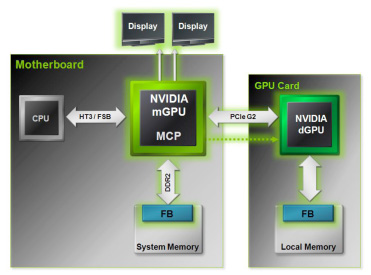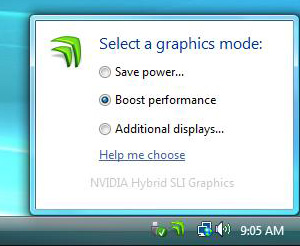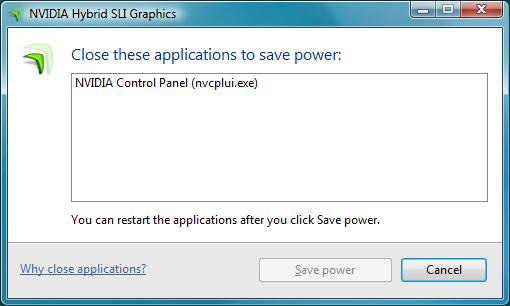NVIDIA 780a: Integrated Graphics and SLI in One
by Gary Key on May 6, 2008 12:00 AM EST- Posted in
- CPUs
Low Power SLI: HybridPower
It's not just the CPU guys that are taking power consumption seriously these days, NVIDIA is too. With the nForce 780a, NVIDIA finally introduces a technology it has been talking about for several months: HybridPower.
With all of NVIDIA's 2008 chipsets featuring integrated graphics, HybridPower enables a discrete graphics card to shut off when not in use, relying on the motherboard's integrated graphics (mGPU) to handle display output.

The technology works like this: the discrete GPU (dGPU) is plugged into a standard PCIe slot, however the display is connected to the mGPU. With HybridPower running in Power Savings mode, the mGPU handles all rendering and display output, while the dGPU remains turned off completely (not idling, but completely turned off, even the fan stops spinning). In Performance Boost mode, the dGPU is turned on and it handles all 3D rendering and display operations but its frame buffer is copied to system memory before being displayed by the mGPU. The dGPU renders all frames but the mGPU actually displays them. Since the dGPU's frame buffer needs to be copied to system memory and is actually displayed by the mGPU there is a small performance hit for enabling HybridPower, thankfully it is negligible.

BIOS and driver support for HybridPower is nothing short of outstanding, the install process is virtually seamless. Generally when dealing with integrated graphics and switching between a mGPU and dGPU you'll need a couple reboots and maybe a reconfigure of the BIOS before you can get display output. With the nForce 780a we simply plugged in a supported NVIDIA GPU and everything else worked itself out.
One problem we countered was related to behavior of the platform with its unsigned graphics driver. The issue is this: the nForce 780a's IGP uses the same graphics driver as the GeForce 9800 GX2 we attempted to install, however that graphics driver won't automatically be installed due to the fact that it is unsigned. It requires a re-run of the NVIDIA installation utility if the user adds a graphics card after the fact in order to get it to install properly. We are assuming that final drivers will be signed and this won't be a problem once the product is available for retail sale, but for now it can be confusing since no errors are thrown and you need to look at device manager before you realize that the GX2 driver wasn't properly installed.
The real problems with HybridPower arise when attempting to switch between using the mGPU and dGPU. The public and reviewers alike were both led to believe (by both AMD and NVIDIA) that the platform/driver would intelligently switch between the mGPU and dGPU - this isn't the
real world functionality of the platform.
Switching between the HybridPower modes must be done manually; while NVIDIA would like for the transition to be automated and seamless, this is the first incarnation of the technology and support for application-sensing technology just isn't there yet.

Luckily, NVIDIA developed a very simple tool that sits in your systray, allowing you to switch between HybridPower modes. Simply right-click the tool, select the appropriate operating mode and the driver enables or disables the appropriate GPU.
There are some limitations; first and foremost, only the GeForce 9800 GTX and GeForce 9800 GX2 are supported by HybridPower. On the chipset side, the nForce 720a, 730a, 750a, 780a and all of the GeForce 8x00 series motherboards support HybridPower. For most users, you'll need a new motherboard and a new GPU to take advantage of HybridPower.
Certain 3D applications won't let you change state while they are running, so you may have to quit applications like 3dsmax before you are able to switch power modes. NVIDIA's utility reminds you of this:

When switching HybridPower modes, the state of one GPU gets moved to the other, meaning that the process isn't instantaneous. The more windows you have open and the more GPUs you have in the system, the slower the process will be. On a single GeForce 9800 GTX it took between 4 and 7 seconds to switch modes, which honestly wasn't too bad.
When we outfitted the system with a GeForce 9800 GX2, featuring two GPUs, the process took up to 13 seconds. The amount of time it takes to switch modes depends entirely on the number of windows open, with 40 windows open the GeForce 9800 GTX took a maximum of around 6 seconds to switch modes, compared to 13 seconds for a GeForce 9800 GX2 thanks to its two GPUs. The transition time would be even higher on a 3 or 4 GPU system.
The type of windows open doesn't seem to have an impact on the transition time between HybridPower modes, simply the number of windows (and their associated memory footprint). The problem is that a dual-purpose machine (one used for work and gaming) can easily have a large number of windows open, and waiting more than 10 seconds for anything to complete easily makes a system feel slow/sluggish.
The power savings were absolutely worth it, see for yourselves:
| Save Power Mode (dGPU Disabled) | Boost Performance Mode (dGPU Enabled) | |
| Total System Power Consumption (Idle) | 115W | 165W |
Since the mGPU is just as capable of decoding HD video as the dGPU in this case, it is possible to build an actual gaming HTPC out of something like the nForce 780a. You no longer have to sacrifice performance in order to keep power consumption down, you can have a multi-GPU setup but still watch movies thanks to HybridPower.
30" LCD Owners Need not Apply
The ASUS M3N-HT Deluxe only offers an analog VGA output as well as a digital, single-link HDMI output. The problem with this configuration is that while it is possible to convert HDMI to DVI, there is no way of outputting a dual-link DVI signal. In other words, the resolutions needed by 30" displays won't be reachable via the mGPU.
If this assumption is correct and there is no way to output a dual-link DVI signal from the mGPU (the reviewer's guide indicates only a single-channel integrated TMDS), then it almost entirely negates the point of HybridPower and 3-way SLI on this motherboard. Anyone investing a serious amount of money into graphics cards may also have reason to invest in a 30" display, which as it stands will be unsupported by this platform unless the display is driven directly off of the graphics cards themselves, in which case HybridPower won't work.
This is absolutely unacceptable and would prevent us from recommending the 780a as anything more than just another SLI motherboard. HybridPower is quite possibly the best feature for a high-end SLI user and if it won't work with 30" displays then its usefulness is severely degraded.
Unfortunately there's no other workaround here, NVIDIA simply chose wrong with its lack of support for dual-link DVI and we won't see this problem fixed until a new revision of the mGPU makes its way into later chipsets.










38 Comments
View All Comments
wjl - Wednesday, May 7, 2008 - link
I tried a Wolfdale 2,6GHz (E8200) with Intel's G35, and it's an improvement already - tho for "serious" HTPC usage, I would probably wait for the G45, which should be out this summer.Sure, Intel chip sets are not flawless, like their drivers also. But Intel and AMD are moving into the right direction, and I wish this would be honoured more when comparison tests like the one here are performed.
The world isn't only Windows, and only gamers - wake up guys. Take the Phoronix test suite if you have to compare and show numbers. I think even this test suite is GPL'ed, so...
Anyway: the ATI/AMD 690G (RS690) will work now with 3D, using only open source drivers - and it's news like these which are really important for the rest of us - not which newest chip set has a few frames per second more or less, which is really ONLY interesting for first person shooters.
Natfly - Tuesday, May 6, 2008 - link
How important is HT3 for the IGP? Is 1080P content watchable without it?
Also, is there an equivalent to AMD's sideport memory that may show up in some 780a/8200 boards?
derek85 - Tuesday, May 6, 2008 - link
HT3 is most important when you watch interlaced contents (1080i) because of the extra HDHQV features require alot more bandwidth than normal 1080p. Theoratically 1080p should be watchable without HT3, but this largely depends on the K8 model you get.I'm not sure about sideport equivalence from NVIDIA, I haven't heard anything related to it and I highly doubt they will be able to come up with one, because that requires modification of their existing blocks which they probably won't bother to spend the time on. If you really want that, just get an AMD board ;)
Natfly - Tuesday, May 6, 2008 - link
Well I was planning on getting a 4850e and have been recently trying to decide between the 780G and 8200. I'd like to get the best IGP performance and also have RAID5 w/out using any extra cards, but that seems impossible at this point. Maybe a manufacturer will pair up 780G with SB750 when it gets released.derek85 - Thursday, May 8, 2008 - link
If you want to max out 3D performance, HT3 is the way to go. HT1 can provide maximum 8GB of bandwidth, HT3 with 1800MHz can provide 14.4GB of bandwidth (2 channel DDR2-800 is 12.8GB). The actual improvement of this reflected in benchmarks such as 3DMarko6 is quite significant (>20%), but nonetheless it is still IGP, so whether you would like to invest more into it is totally up to you.Von Matrices - Tuesday, May 6, 2008 - link
Is my PC at fault or does anyone else notice the horrible compression of the charts on page 6?JarredWalton - Tuesday, May 6, 2008 - link
Fixed... Gary changed the chart sizes but didn't update the HTML (where a smaller width and height was hard-coded). Shame on him. I have had him flogged with a Cat-o-nine-SATA-cords.Mgz - Tuesday, May 6, 2008 - link
in page 4 you have a little typo "we can't really be sure until NVIDI confirms the details"homerdog - Tuesday, May 6, 2008 - link
I appreciate the effort by Nvidia to reduce idle power consumption, but I would much rather see a discrete GPU that doesn't draw so much power when idling in first place. ATI has been making significant strides in this department lately with PowerPlay, and EVERY motherboard/configuration benefits. Having two GPUs with redundant framebuffers is going around your elbow to get to your ******* if you ask me.ChrisRay - Tuesday, May 6, 2008 - link
HomerDog. Not sure I entirely understand your problem with Hybrid Power. Its basically a technology that lets you shut of your discreet GPUS completely. No amount of power saving tech is going to have that measure of impact. ((Or system noise impact)).Your right that every motherboard benefits from power saving tech on discreet GPUs. But the difference in power saving by using a feature like Hybrid power is huge compared to any idle technology existing on GPUS. Browsing from my desktop with Hybrid Power enabled and Quad SLI 9800GX2. My AVG room temp went down 4-5C after 2 hours of web activity from having hybrid power enabled. Thats significant.
SLIZONE Forum Admin.
Nvidia User Group